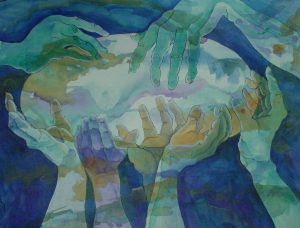 The Yogabliss, Two Rivers/RiverTree Yoga on-line Moving into Meditation classes met this morning. Today we shared guided meditation and somatic practices to explore how we experience and relate to our bodies when they are in pain. Pain calls for our attention, right now. Our experience of pain is strongly influenced by how we respond to that call.
The Yogabliss, Two Rivers/RiverTree Yoga on-line Moving into Meditation classes met this morning. Today we shared guided meditation and somatic practices to explore how we experience and relate to our bodies when they are in pain. Pain calls for our attention, right now. Our experience of pain is strongly influenced by how we respond to that call.
We shared meditation teacher Oren Jay Sofer’s reflections on the role compassion plays in our experience of pain. You can find his very helpful essay, Five Mindfulness Tools for Pain, and his guided Meditation Resources for Pain on his web-site.
We heard Jane Hirshfield’s poem My Skeleton. The poem describes the body as a silent partner with whom we walk through life – alternately holding and being held. We also heard reflections from her Tricycle Magazine interview, Felt in Its Fullness. She describes how intimate somatic awareness in meditation offers us deeper understanding of ourselves and our place in the world.
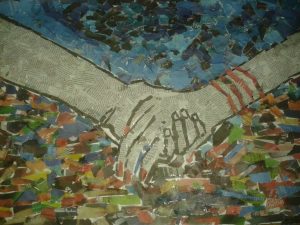 We explored poet David Whyte’s reflections On Pain. He describes how our world becomes smaller when we are living with pain. It also grows larger as we reach for help and as we are able to understand we aren’t alone in pain.
We explored poet David Whyte’s reflections On Pain. He describes how our world becomes smaller when we are living with pain. It also grows larger as we reach for help and as we are able to understand we aren’t alone in pain.
In his essay, Guide to Finding Courage in Difficult Times, David explores how we find solace. He encourages us to draw on the innate wisdom of the body which can guide us in choosing whether to investigate closely or to shift our awareness away from painful sensations.
Relaxed Reflection
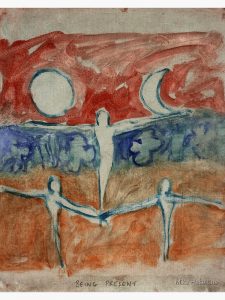 Welcome to this space that we create out of time and presence. In presence we give each other our faces – seen through screens – they still convey caring, curiosity . . . Each of our faces tell the continuing story of our life journeys. Our bodies wear the marks of living . . . the pleasures, pains, joys and sorrows. We feel pain calling our attention in moments or for long times. We can move toward discomfort or try to escape. So often our escapes create more suffering. In meditation we answer the call for attention. We feel, investigate and query. Can we sense our areas of our body support our well being? Do we notice any areas of discomfort or pain? How are we relating to these sensations?
Welcome to this space that we create out of time and presence. In presence we give each other our faces – seen through screens – they still convey caring, curiosity . . . Each of our faces tell the continuing story of our life journeys. Our bodies wear the marks of living . . . the pleasures, pains, joys and sorrows. We feel pain calling our attention in moments or for long times. We can move toward discomfort or try to escape. So often our escapes create more suffering. In meditation we answer the call for attention. We feel, investigate and query. Can we sense our areas of our body support our well being? Do we notice any areas of discomfort or pain? How are we relating to these sensations?
We often treat our body as the silent partner who does our bidding. Our dear partner is not a machine – its nature is to suffer age, illness and death. In our practice we can listen to our body expressing pleasure or pain, vitality or fatigue. We reflect on what we notice: If there is an area or a memory of discomfort, can we bring some compassion for ourselves and for the pain? As if relating to a friend or loved one who is suffering. Can there be a sense of soothing? Do we find ourselves resisting, feeling frustrated, angry or fearful? We can notice whether we seem to be adding mental and emotional stress to discomfort. What would it be like to soften around the experience? Can we give our selves a little more space . . . more ease or balance?
Sometimes finding balance means shifting attention away from painful sensation.
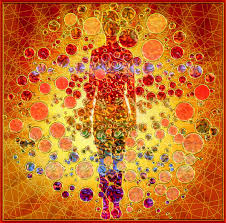 If the pain is intense and unrelenting we can try focusing on another more neutral or pleasant sensation or something broader like sound or space. With loving awareness and caring we can find our way to balance. With wisdom we understand that balance is alive and moving, continuously changing. The very nature of life calls for compassion. As meditation teacher Oren Jay Sofer writes:
If the pain is intense and unrelenting we can try focusing on another more neutral or pleasant sensation or something broader like sound or space. With loving awareness and caring we can find our way to balance. With wisdom we understand that balance is alive and moving, continuously changing. The very nature of life calls for compassion. As meditation teacher Oren Jay Sofer writes:
Compassion is the beginning, the end, and hopefully the underlying tone throughout. This is more than just feeling tenderness towards one’s own pain. Compassion connects us to one another. When we reflect, we realize that all creatures feel pain. Instead of being alone in our suffering, we can find a beautiful release in the way that it softens our heart, and connects us to the world.
In her poem, My Skeleton, Poet Jane Hirshfield writes of the deeply intimate relationship we hold with the body:
My skeleton,
who once ached
with your own growing larger
are now,
each year
imperceptibly smaller,
lighter,
absorbed by your own
concentration.
When I danced,
you danced.
When you broke,
I.
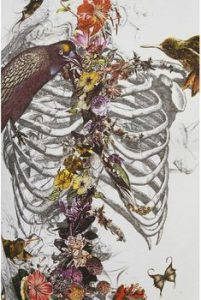 And so it was lying down,
And so it was lying down,
walking,
climbing the tiring stairs.
Your jaws. My bread.
Someday you,
what is left of you,
will be flensed of this marriage.
Angular wrist bone’s arthritis,
cracked harp of ribcage,
blunt of heel,
opened bowl of the skull,
twin platters of pelvis—
each of you will leave me behind,
at last serene.
What did I know of your days,
your nights,
I who held you all my life
inside my hands
and thought they were empty?
You who held me all your life
in your hands
as a new mother holds
her own unblanketed child,
not thinking at all.
We hold our silent partner in our hands and we are held so nakedly in return.
As you lay down feel yourself held . . . and feel yourself holding . . . Where can you feel this sense of “me”? How do you feel this sense of “I”? Open to the many, many communications uncloaked by words . . . In her Tricycle Magazine interview, Felt in Its Fullness, Jane said:

. . . [In]meditation. One breath leads to another. Some breaths are transparent, some are filled with silent weeping. Some tremble on the cusp of disappearance, others become the sound of cars or birds.
Closely attended, any moment is boundless and always changing. You emerge from these kinds of undoing awareness and you know it is not you yourself who are all-important. You know something of the notes of your own scale.
We are here experiencing every kind of breath that arises . . . present for grief, sound and change . . . What is worth paying attention to right now? Who is all-important? The notes of our own scale are part of the world’s music. The experience of pain draws our attention to the right now and often forces us to reach beyond ourselves. In his essay On Pain poet David Whyte writes:
 In deep pain we have energy only for what we can do wholeheartedly and then, only within a narrow range of motion . . . from tying our shoe-lace to holding the essential core conversations that are reciprocal and reinforcing within the close-in circle of those we love. Pain teaches us a fine economy, in movement, in what we choose to do, in the heart’s affections, in what we ask of our selves and eventually in what we ask of others.
In deep pain we have energy only for what we can do wholeheartedly and then, only within a narrow range of motion . . . from tying our shoe-lace to holding the essential core conversations that are reciprocal and reinforcing within the close-in circle of those we love. Pain teaches us a fine economy, in movement, in what we choose to do, in the heart’s affections, in what we ask of our selves and eventually in what we ask of others.
. . . In real pain we have no other choice but to learn to ask for help on a daily basis. Pain tells us we belong and cannot live forever alone or in isolation. . . .
Pain is the first proper step to real compassion; it can be a foundation for understanding all those who struggle with their existence. . . .
 Right now you can reflect on your own experience of pain – feeling it in meditation or recalling a memory. How did your world grow smaller? Were you able to ask for and receive help? Can you offer these reflections loving awareness . . . Can you extend a tenderness toward your experience? Sometimes that tenderness means moving away or closer in . . . honor what is true for you.
Right now you can reflect on your own experience of pain – feeling it in meditation or recalling a memory. How did your world grow smaller? Were you able to ask for and receive help? Can you offer these reflections loving awareness . . . Can you extend a tenderness toward your experience? Sometimes that tenderness means moving away or closer in . . . honor what is true for you.
In his Guide to Finding Courage in Difficult Times, David Whyte writes:
Solace is the art of asking the beautiful question of ourselves, of our world or of one another, in fiercely difficult and un-beautiful moments. Solace is what we must look for when the mind cannot bear the pain, the loss or the suffering that eventually touches every life and every endeavor; when longing does not come to fruition in a form we can recognize, when people we know and love disappear, when hope must take a different form than the one we have shaped for it.
. . . Solace is found in allowing the body’s innate wisdom to come to the fore, the part of us that already knows it is mortal and must take its leave like everything else, and leading us, when the mind cannot bear what it is seeing or hearing, to the birdsong in the tree above our heads. . .
It is our silent partner who calls for our loving awareness, our care, our compassion. It is a great blessing when we are able to answer that call.
